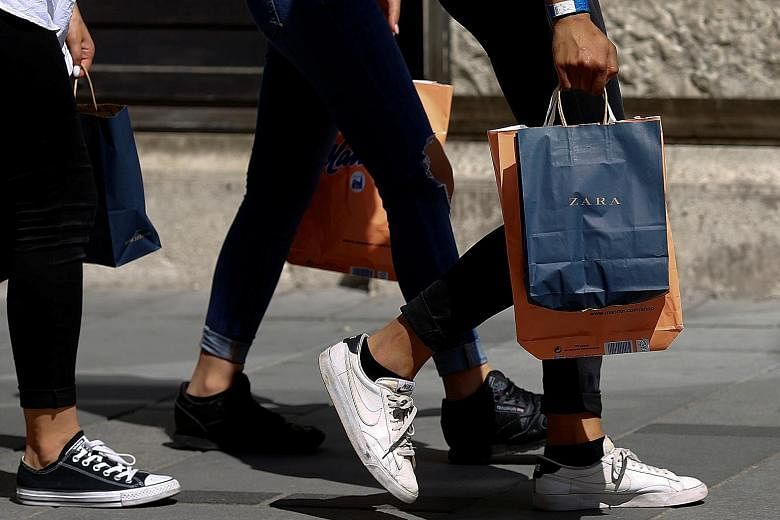Money looks better in the bank than on your feet, said fashion entrepreneur Sophia Amoruso, who built an e-commerce empire from the Nasty Gal Vintage eBay store she set up in 2006 in San Francisco.
But try telling me that when I'm wearing my special-edition adidas UltraBoost running shoes, which I bought at a premium in Osaka but have used only twice since.
For all the saving, investing and, at times, frugality that I advocate, I often fall prey to the effects of capitalism - consumerism leading to materialism, driven by the desire to own things that I want instead of need.
Apart from food, I've long accepted shopping as my other weakness, but I assure you that steps have been taken over the years to curb excessive behaviour and embrace minimalism.
And instead of preaching about how to save oneself from the evils of shopping, I've found ways to spend less while doing so.
I mostly shop overseas as that helps me avoid temptation here. I can also find unique items, and even buy the same thing for less than what it costs locally.

You could say spending on the airfare probably cancels out whatever you "saved" or you shouldn't be buying at all.
But if my travel plans take me to a particular country where the same item costs less than in Singapore, I see no harm in planning ahead, armed with a shopping list for things I need or want.
For instance, whenever I visit Seoul, I stock up on ramyun noodles made in South Korea, for less than a dollar a packet. The same thing could cost about $1.50 a packet here - and only the made-in-China version might be available locally.
The idea that brands are cheaper from their country of origin applies across several categories, from food to clothes to luxury goods.
Established fashion website Who What Wear ran a piece last year highlighting price differences for Spanish fast fashion retailer Zara in several markets such as the United States and Britain.
Zara products are priced the lowest in Spain, and are the most costly in Japan and the US, where they are almost 40 per cent more.
You could even go one step further and visit Zara outlet stores called Lefties. Beauty magazine Allure noted earlier this year that "prices average about a third cheaper than in regular Zara stores", and you can even find exclusive collections.
However, before visiting outlet stores and buying something that says it's half the original price, remember that some of these items are made just for the outlets, and might not even have been sold in regular stores before.
Or you could take the luxury route with French names like Goyard and Saint Laurent, and a dozen other big brands. Prices can be at least 10 per cent less - which can add up when you're buying a big-ticket item.
However, high-end labels tend to raise their prices from time to time, especially with the euro depreciating over the years, so it is best to check prices before you take the leap.
Also capitalise on your tourist status for slightly more palatable prices, as the goods and services tax (GST) is dropped from your shopping bill.
Tax rates vary in Europe, going up to 27 per cent for some countries, while most goods in Hong Kong are tax-free. Do your homework, and you can still enjoy some savings on your shopping, even with the GST imposed when you return.
Going online could save you a pretty penny as well. I started buying hair products via e-commerce platform Qoo10 because I happened to find the exact items I wanted for less.
I even found a specific brand that was sold in bulk online, whereas I could get only the retail-size products in stores or salons here, and those items could be outdated at times.
My colleague Y just discovered a Coach space-themed bag that's $995 here, but $800 online at Neiman Marcus, which ships here.
The option of saving money by not buying the bag at all has prevailed for her, for now.
I strongly suggest you go online with a specific goal in mind, instead of giving in to boredom or emotions.
I've stopped mindless scrolling through the website of Asos, a British online fashion retailer, or any other fashion or commerce site, for a few years now.
I was enticed to shop online only because the clothes were ridiculously cheap. Sometimes, the quality was great, but I never actually needed them.
The same goes for bargain buys in cities such as Bangkok or Hong Kong. I do my best now to exercise restraint, seek quality goods and ask: "Do I really need this?" The answer is almost always no.
There are countless reasons why I'm still not immune, and I've read them all.
An online Time magazine article suggests choice-support cognitive bias, "in which we ignore information that doesn't support our desires", where perhaps you buy shoes that hurt but were on sale and you thought looked good.
The article also notes that when people shop, they visualise their future selves - who they could be, how the purchase would make them feel or what others would think.
Australian site news.com.au quotes an expert in brain health saying it's just how our brain works - it reacts to buying things.
The piece notes that we have a fear of missing out or feel a sense of satisfaction when buying something we want, or even feel rewarded if we are buying things for someone else.
So don't beat yourself up too much if you find yourself occasionally buying stuff you want. Take heed from Tom of comedy television series Parks And Recreation, with his annual epic "Treat Yo' Self" day, as Y reminds me from time to time.
Despite the wise words of Ms Amoruso - now the subject of a newly released Netflix series Girl Boss - her fashion brand Nasty Gal filed for bankruptcy in November last year, even though sales hit almost US$100 million (S$139 million) at one point in 2012.
Analysts said that Nasty Gal grew too fast thanks to heavy spending on marketing and advertising. If it had kept its money in the bank and sharpened its business strategy, perhaps things would be different today.
That teaches me that things happen despite my best efforts and, if all else fails, at least I have a pair of super-comfortable shoes that make me feel like I'm walking on clouds.


